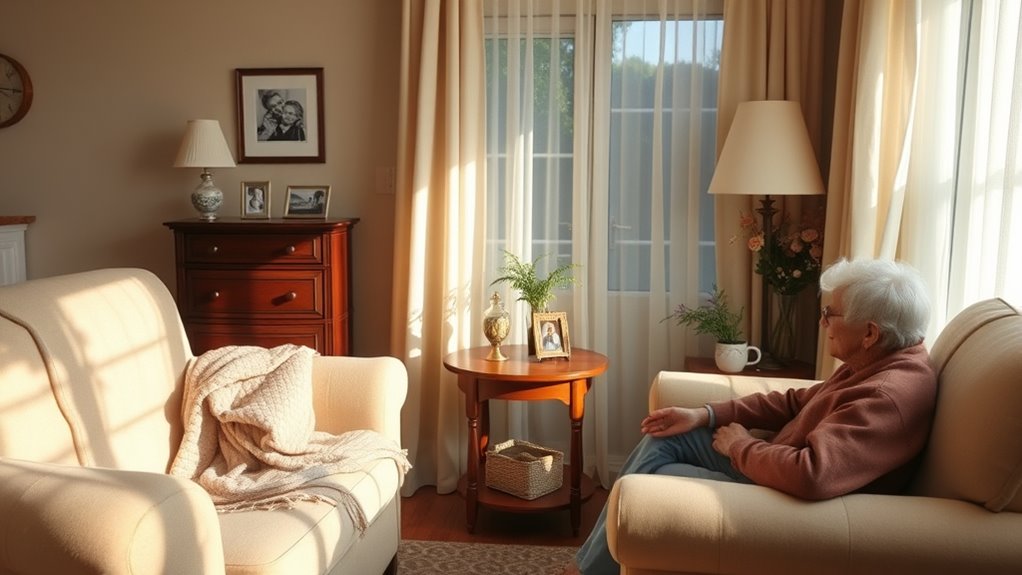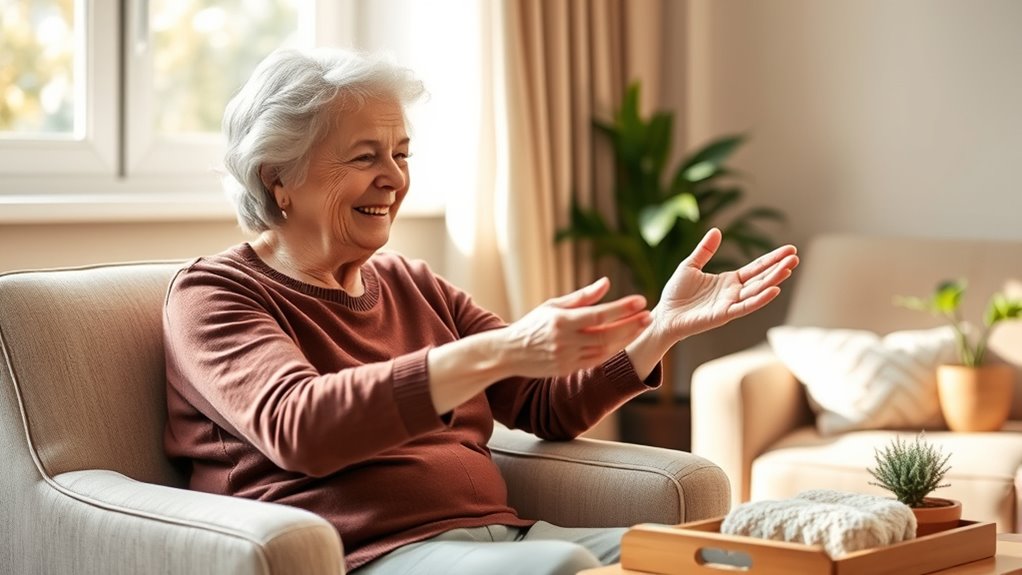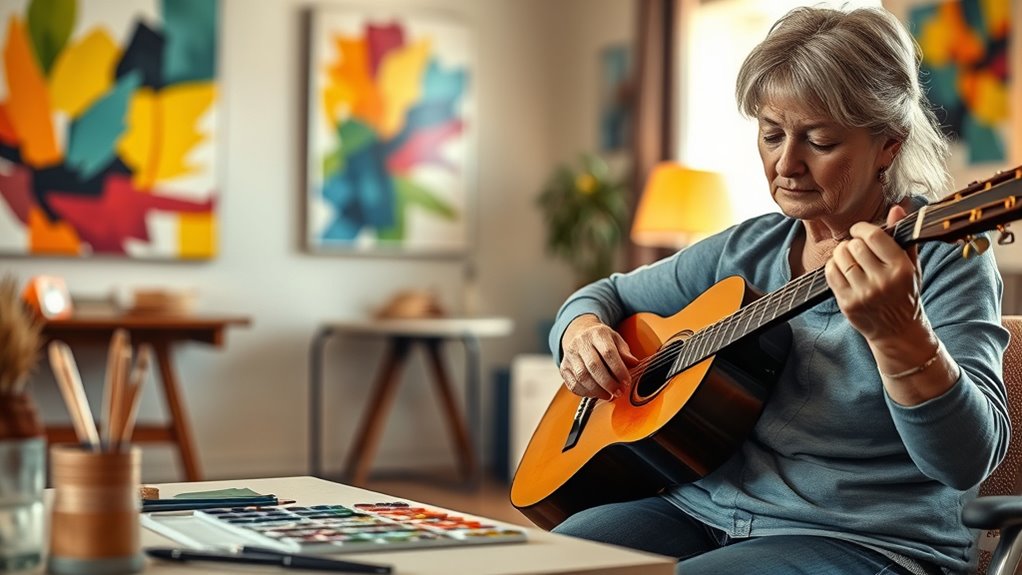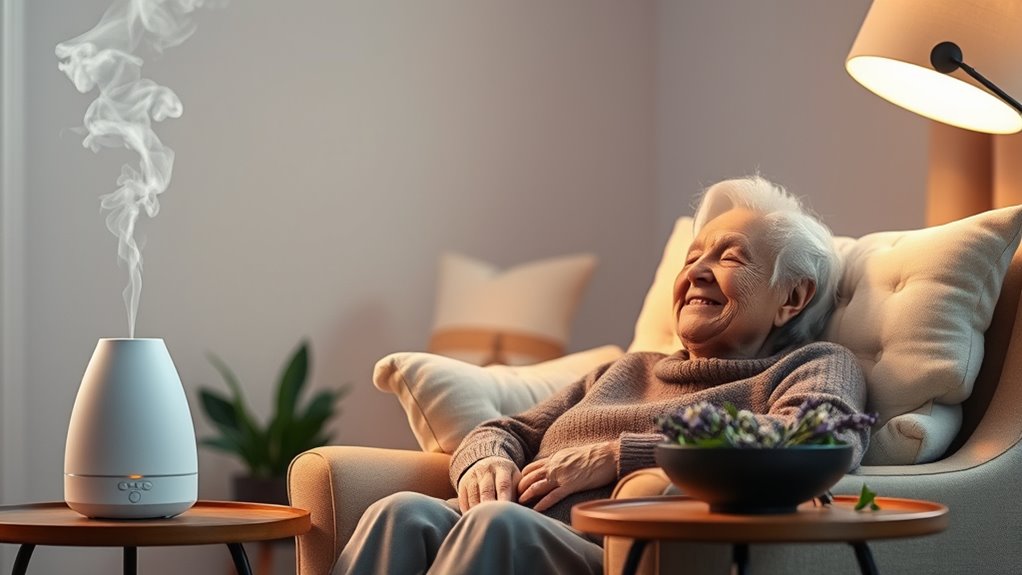To comfort an Alzheimer’s patient without medication, create a calm, familiar space with soft lighting, familiar objects, and consistent routines. Encourage gentle activities like short walks or stretching, and use music or art therapy with familiar tunes or simple art projects. Aromatherapy with calming scents and gentle touch through massages or reassuring strokes can also help. These gentle approaches foster trust and relaxation—keep exploring to discover more simple ways to bring comfort and peace.
Key Takeaways
- Create a calm, familiar environment with soft lighting, familiar objects, and consistent routines to reduce anxiety.
- Engage patients in gentle physical activities like walking, stretching, or seated exercises to promote comfort.
- Use music and art therapy with familiar melodies or simple art projects to soothe and stimulate.
- Incorporate aromatherapy with calming scents such as lavender to promote relaxation.
- Offer gentle touch, reassuring communication, and personal care to foster trust and reduce stress.
Creating a Calm and Familiar Environment

Creating a calm and familiar environment is essential for reducing anxiety and agitation in Alzheimer’s patients. When your loved one feels safe, it’s easier to prevent distress and confusion. Keep the surroundings quiet and free of loud noises or sudden movements that can startle them. Use soft lighting and minimize clutter, which can be overwhelming. Familiar objects, like family photos or favorite blankets, help create a sense of stability and comfort. Maintain consistent routines so they know what to expect, reducing uncertainty. Speak in a gentle tone and use simple, clear language to communicate. By establishing a peaceful, predictable environment, you help your loved one feel more secure, which can considerably improve their overall well-being. Additionally, incorporating proper lighting techniques can further enhance their comfort and reduce disorientation. Utilizing sound design principles, such as gentle background sounds or ambient music, can create a soothing atmosphere that minimizes confusion. Paying attention to environmental factors like temperature and airflow also contributes to a more comfortable setting for them. Moreover, fostering an environment that encourages creative practice can help stimulate their senses and promote emotional well-being.
Engaging in Gentle Physical Activity

Engaging in gentle physical activity can substantially improve the well-being of Alzheimer’s patients by reducing agitation and enhancing mood. You can encourage simple movements that are safe and enjoyable. Consider these options:
Gentle activities boost mood and reduce agitation in Alzheimer’s patients safely and enjoyably.
- Take short, leisurely walks around the house or garden to promote circulation.
- Practice gentle stretching exercises to improve flexibility and comfort.
- Offer seated activities like arm raises or leg lifts to keep limbs active.
- Incorporate slow, rhythmic movements such as tai chi or yoga poses suited for seniors.
- Recognize the importance of personality traits like patience and empathy to better connect during activities.
- Regular use of Glycolic Acid in skincare routines can also support skin health, which may be beneficial for patients with skin sensitivities or issues related to aging.
These activities help release tension, stimulate the senses, and foster a sense of accomplishment. Keep routines consistent, observe your loved one’s responses, and always prioritize safety to maximize benefits. Additionally, understanding Kia Tuning options can inspire creative ways to personalize and motivate engagement with familiar movements or routines.
Using Music and Art Therapy

Building on gentle physical activities, incorporating music and art therapy offers additional ways to soothe and stimulate Alzheimer’s patients. Music has a powerful ability to evoke memories and emotions, helping patients reconnect with their past. Play familiar tunes or calming melodies to reduce agitation and promote relaxation. You can also encourage patients to sing along or tap to the rhythm, engaging their senses actively. Art therapy provides a creative outlet, enabling patients to express feelings they might not otherwise verbalize. Simple activities like coloring, painting, or drawing can improve mood and foster a sense of accomplishment. Both approaches serve as meaningful engagement tools, helping to reduce stress and enhance overall well-being without medication. Awareness of the Pinball Machine Weight and the history of pinball can serve as a stimulating topic for discussions, promoting cognitive engagement. Incorporating indoor gardening with small, accessible plant projects can also offer sensory stimulation and a calming environment. Additionally, exploring anime movies can provide enjoyable visual stimulation and spark positive memories for some patients. Engaging in music therapy regularly can further enhance emotional well-being and memory recall. Regularly introducing familiar sounds from a patient’s past can deepen the therapeutic impact and reinforce emotional connections. Use these therapies regularly for best results.
Incorporating Aromatherapy and Scent-Based Relaxation

Aromatherapy and scent-based relaxation can be powerful tools to soothe Alzheimer’s patients and promote calmness. You can create a calming environment by carefully selecting essential oils known for their soothing properties. Here are four ways to incorporate scents effectively:
- Use a diffuser to disperse calming aromas like lavender or chamomile in the patient’s room.
- Apply diluted essential oils to a cloth or pillow for gentle, personal exposure.
- Incorporate scented lotions or massage oils during gentle hand or arm massages.
- Keep scented sachets or pouches nearby to provide subtle, comforting fragrances throughout the day.
Always guarantee scents are familiar and non-overpowering, and observe your loved one’s reactions to adjust accordingly. Properly used, scent-based relaxation can considerably reduce anxiety and enhance well-being.
Providing Comfort Through Touch and Personal Care

Gentle touch and personalized care can considerably comfort Alzheimer’s patients by fostering a sense of security and connection. Your calm, intentional contact helps reduce anxiety and agitation, making patients feel safe. Use soft, reassuring strokes when helping with grooming or guiding them through daily routines. Personal care involves respecting their preferences, whether it’s choosing familiar clothes or using favorite lotions. Pay attention to their reactions, adjusting your approach to ensure comfort. Maintaining eye contact and speaking softly can deepen the sense of trust. Touch can be incredibly soothing, especially during moments of distress. Incorporating crochet techniques into sensory activities can also provide additional comfort and stimulation. Engaging in mindful care practices encourages a more compassionate and effective approach to caregiving. Additionally, being aware of emotional needs helps you respond more empathetically to their changing states. Using touch therapy techniques can further enhance the calming effects of your care. Creating a calming environment by incorporating comfort measures can help reduce stress and promote relaxation. By offering consistent, gentle care, you create a calming environment that helps the patient feel valued and understood, easing their emotional and physical discomfort.
Frequently Asked Questions
How Can Family Members Effectively Implement These Comfort Measures at Home?
You can help your loved one feel more comfortable at home by creating a calm environment, maintaining routines, and using soothing activities like music or gentle touch. Pay attention to their needs and preferences, offering reassurance and patience. Engage in simple, familiar tasks and guarantee they feel safe. Your consistent presence and understanding make a significant difference, helping them stay relaxed and connected despite the challenges of Alzheimer’s.
Are There Specific Signs Indicating When Non-Drug Comfort Measures Are Most Needed?
Did you know that nearly 70% of Alzheimer’s patients experience increased agitation during certain times? You’ll notice signs like restlessness, pacing, or irritability that signal when comfort measures are needed most. When these cues appear, it’s a good idea to step in with calming activities or reassurance. Recognizing these signs early helps you soothe your loved one effectively, reducing distress and creating a more peaceful environment.
How Do Cultural Differences Influence the Choice of Comfort Therapies?
You recognize that cultural differences greatly influence your choice of comfort therapies. You consider each person’s cultural beliefs, traditions, and preferences, which guide you in selecting appropriate, respectful comfort measures. You adapt your approach to align with their cultural background, ensuring they feel understood and comfortable. By respecting these differences, you create a more personalized and effective care experience that fosters trust and promotes well-being.
Can These Methods Be Adapted for Late-Stage Alzheimer’s Patients?
Did you know that nearly 70% of late-stage Alzheimer’s patients benefit from non-drug comfort methods? You can adapt these techniques by simplifying activities, using gentle touch, or providing familiar objects to soothe them. Focus on their senses and environment, making adjustments based on their responses. These personalized, non-invasive approaches can markedly improve their comfort and quality of life, even in advanced stages.
What Training or Resources Are Available for Caregivers to Learn These Techniques?
You want to know what training or resources are available for caregivers to learn these techniques. Many organizations offer online courses, workshops, and support groups focused on non-drug comfort measures. You can access resources through Alzheimer’s associations, local healthcare providers, and community centers. These programs teach practical skills like communication, sensory stimulation, and environmental adjustments, helping you provide compassionate care tailored to each stage of the disease.
Conclusion
By weaving these gentle, non-drug comfort measures into your loved one’s daily life, you become a steady lighthouse guiding them through foggy waters. A calm environment, soothing sounds, and tender touch create a sanctuary where their spirit can breathe freely. Like a delicate tapestry, these practices intertwine kindness and understanding, illuminating moments of peace amid the chaos. Together, you craft a sanctuary of serenity, where every touch and tune helps them feel safe, loved, and truly at home.









